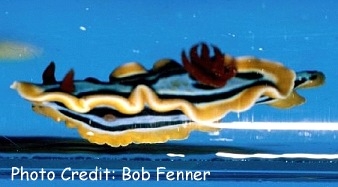
By Bob Goemans


Not Reef Tank Suitable
Not Suitable for Fish-Only Tank
This is the most physically diverse subclass of gastropods with over 3000 known species. The name nudibranch means naked gills since their feather-like gills are generally exposed along their dorsal area. However, some species, i.e., Phyllidiids, the gills are beneath the mantle. Some species can increase their gaseous exchange by ruffling the mantle edge or through small projections called cerata, which contain stinging nematocysts derived from their diet.
They have caught the interest of some marine hobbyists because of their exquisite colors, which actually serve as a warning to predators. Mostly small, less than 3 inches (7 cm), these snails without a shell are all carnivorous. In the aquarium their natural food source is mostly in short supply, limiting their life span considerably. In fact, lifespan of most nudibranchs is less than one year from time of hatching. Fish won't eat them as they have a strong acid gland that makes them taste terrible. Since they are basically predatory animals, they often find anemones, gorgonian, hydroids, tunicates and sponges a delicacy.
And since its almost impossible to judge their food needs, they often perish in aquaria and this poses a serious health risk to the other inhabitants in the same system. Since most are toxic and short lived in captivity, it simply does not make sense, unless you're fully aware of the specimens needs, to house it in your aquarium.
The taxonomy of the Suborder Nudibranchia is still under investigation, but for the sake of simplicity I'll subdivide it into several Superfamilies.
FYI: DNA sampling has resulted in many updates to classification of various species, and as 2017 the following in all Superfamilies is the latest information available for the purpose of this website.
This grouping contains those in the Superfamily Doridoidea - those having the most common species known to aquarists.
These nudibranchs have a pair of tentacles near the top of the head and several feathery gills near the rear section. Their members feed upon specific sponges, barnacles, sea squirts, soft corals, hydrozoans, hydroids and bryozoans and/or release toxic chemicals fatal to shrimp and fishes.